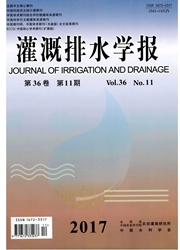

 中文摘要:
中文摘要:
通过内蒙古河套灌区义长灌域野外38个测点的光谱试验,提取反射光谱的盐分指数和吸收光谱的特征参数,研究砂土、砂壤土、壤土土壤合盐量的高光谱定量反演技术。结果表明,针对不同土质,提取最佳盐分指数的组成波段和回归建模的精度都不同;壤土提取最佳盐分指数的组成波段为95lnm和952nm,回归方程精度最高(R^2adjust为0.88);砂壤土提取最佳盐分指数的组成波段为670nm和67lnm,回归方程精度最低(R^2adjust为0.55);若不考虑土质因素,提取最佳盐分指数的组成波段为651nm和653nm,回归方程的R^2adjust为0.58。350~593nm波段范围内.吸收峰位置、不对称性与不同土质土壤含盐量的相关性相对较好,但反演不同土质含盐量的精度一般(R^2adjust最大为0.22),这说明可见光-近红外波段范围含盐量光谱的吸收特征不明显。
 英文摘要:
英文摘要:
Through 38 points spectral field experiments in Yichang irrigation field of Hetao irrigation district, Inner Mongolia, the hyperspectral quantitative inversion techniques of soil salt in sandy soil, sandy loam and loam were studied based on the extracted salt indexes of reflectance spectra and absorption features. The results showed that the optimum bands for salt indexes and precision for calibrated models were various in different soil textures. The model for loam had the highest accuracy with R^2adjust of 0. 88, whose constituted bands were 951 nm and 952 nm. Whereas, the model for sandy loam had the lowest accuracy with R^2adjust of 0.55, whose constituted bands were 670 nm and 671 nm. Taking all samples into consideration without soil texture classification, R^2adjust was 0. 58 for optimum salt index comprised by 651 nm and 653 nm. In the range from 350 mm to 593 nm, there were obvious relative relationships between absorption summit location, asymmetry and soil salt content, however, the precision of the inversion model based on the two variables was low and the top of R^2adjust only was 0. 22, which implied unconspicuous absorption features of soil salt in the range of visible and near-infrared spectrum.
 同期刊论文项目
同期刊论文项目
 同项目期刊论文
同项目期刊论文
 期刊信息
期刊信息
